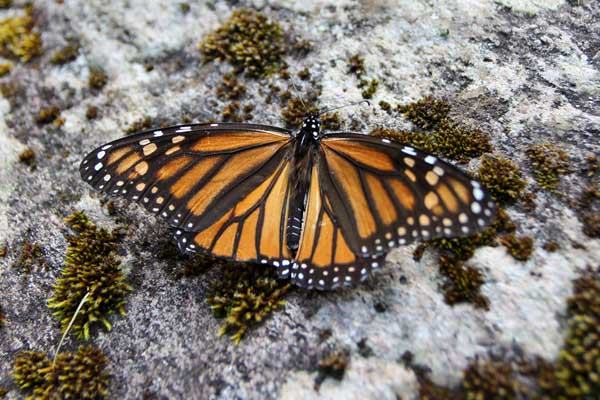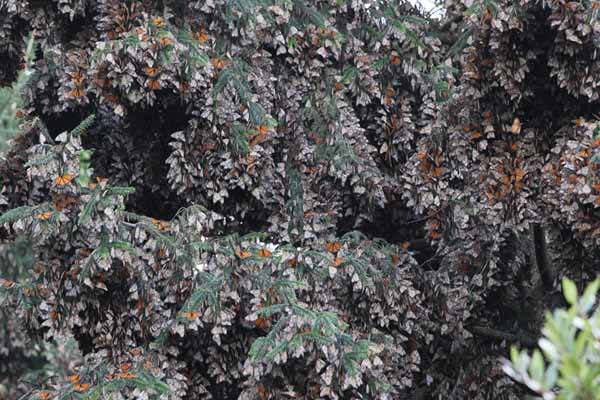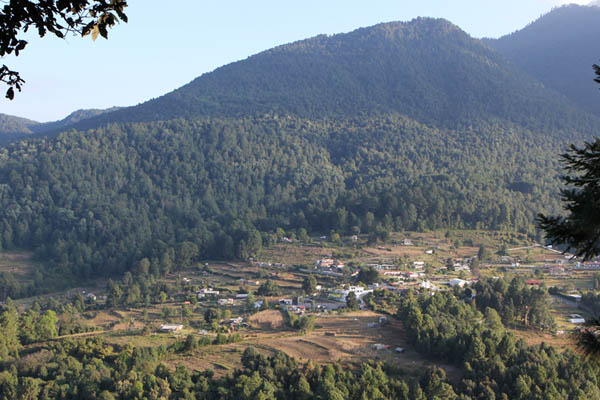Photos with this report (click to enlarge) | |||
 Monarch (Danaus plexippus) |
 Monarch (Danaus plexippus) |
 Macheros |
|
Background
Ever since we spent a fall field season at Cape May, New Jersey in 2005 and learned about the incredible long-distance migration of the Monarch Butterfly (Danaus plexippus), we have dreamed of visiting the wintering grounds in Mexico. It became a bucket list experience! Our travel choices are often influenced by the timing of available vacation and the prices of airfare, so when tickets to Mexico City over New Year came up as cheap, we snapped them up and started to plan our trip to see the monarchs. We'd soon be ticking a trip off our bucket list! In addition to the monarchs, we took a one-night trip east of the city to the ruins at Teotihuacan, a birding day trip to Cuernavaca (Morelia), and some sightseeing in CDMX. This trip report deals only with our visit to the monarch butterfly sanctuary.
General info about the monarchs
A large portion of the migratory population of monarchs winters in the mountains of Central Mexico. The traditional wintering sites are in the high montane fir forest (~2700-3100m) west of Mexico City along the border between the states of Michoacán and Mexico, where constant cool temperatures allow them to remain dormant for much of the time. The predominant tree species is the oyamel (Abies religiosa), or sacred fir in English. Monarchs arrive to the wintering sites in November and depart for the north in March. The spectacle of the monarchs impressed the ancient indigenous peoples of the region, who associated the annual migratory flights with the spirits of the deceased returning to Earth. More recently UNESCO recognized the monarch wintering grounds as a World Heritage Site.
The Monarch Butterfly Biosphere Reserve (Reserva de la Biósfera de la Mariposa Monarca) has four main access points for visitors:
El Rosario (eBird hotspot: http://ebird.org/ebird/hotspot/L221359)
This is most commonly visited sanctuary, accessed via the town of Angangueo in Michoacán, and it is the most developed and most touristic. Most recently it has hosted the highest populations of monarchs. The viewing of the colony at El Rosario may be somewhat more distant here than some other sites.
Sierra Chincua (eBird hotspot: http://ebird.org/ebird/hotspot/L221359)
Sierra Chincua has the simplest approach, with an easy walk over relatively level terrain. It's located north of El Rosario.
Cerro Pelón (eBird hotspot: http://ebird.org/ebird/hotspot/L221367)
Cerro Pelón lies on the border of Michoacáan and Mexico and is usually accessed from the ejidos of Macheros or El Capulín. It is the least developed and most rustic of the sanctuaries. This is the site we visited and we enjoyed these features!
Piedra Herrada (eBird hotspot: http://ebird.org/ebird/hotspot/L5261762)
This sanctuary is set southeast of the others and somewhat apart in the state of Mexico.
Planning
We heard about JM's Butterfly B&B in Macheros from a birding friend and decided to give it a try as our base. I found no detailed birding trip reports online dealing with the monarch sanctuaries, so I had no other solid leads to go on. JM's website ( http://jmbutterflybnb.com) was through and they were responsive to our inquiries, which was encouraging. With fairly limited time to devote to planning, I decided to focus on possible lifers that might be available to me, based on range maps and known elevation. eBird was somewhat helpful but the data are pretty light in this region! I used Xeno-canto ( http://www.xeno-canto.org/) to find and download recordings for study and field reference.
Travel Logistics
The gateway to the region of the monarch butterfly reserve is Zitácuaro, Michoacán. This medium-sized city is the regional transportation hub. To get there we followed information provided by the B&B, taking a bus from the Terminal Poniente bus station in Mexico City. This terminal is west of the city center and adjacent to the Observatorio metro stop. We found the Terminal Poniente to be large and crowded but it was sufficiently modern and we did not feel unsafe. We bought our tickets from "La Línea", a company that runs a direct route to Zitácuaro. It was a bit confusing, as first we got in the wrong line and then we had to wait for a later departure because the first one was sold out, but we were eventually able to get it sorted out. We thought the Terminal Poniente might be a little overwhelming for inexperienced Latin American travelers, especially non-Spanish speakers.
The "directo" bus takes you to Zitácuaro in about 2 hours, and from there we had arrange to have a taxi waiting to take us to Macheros, a half-hour drive. We called the taxista (René) when we were leaving Mexico City to calculate our arrival time, and he was waiting when we arrived. This was arranged in advance through the B&B. There's plenty of info about traveling to Macheros on the JM website: ( http://jmbutterflybnb.com/directions).
True to its name, JM's is a bed-and-breaskfast run by Joel and Elena, a Mexican-American couple. Joel grew up in Macheros. Travelers can stay at the B&B (or camp on their property) and buy meals other than breakfast next door at the small restaurant operated by Joel's family. We found the our room to be quite comfortable, and the food to be pretty good, and reasonably priced. Macheros seemed like a pleasant enough little village. As you might imagine, it was quite noisy on New Years eve, with fireworks, loud music, and revelry!
Birding Cerro Pelón
The monarch colony is about 5.3 kilometers (3.3 miles) up the mountain from Macheros. To visit you must hire a local guide from the ejido. This is important because it lends an element of profitability to the monarch sanctuary for the local people and enhances the sustainability. The guides are assigned based on a rotating list and they have varying degrees of dedication and patience. JM's offers the service of a butterfly tour, including their own in-house guide. This includes lunch, horse rental, English language interpretation, and ensures you can go at your pace. We elected to pay for the tour and it turned out that Joel accompanied us as our guide. We found him to be great company and although he knew next to nothing about birding he was eager to learn. The tour price includes horse rental and some might find the horses to be essential for completing the trek, which ascends around 700m from Macheros to the monarchs. However, we chose to go on foot for better birding opportunities. We found the trail to be steep in some places but very manageable for us. (We hike regularly and live in a mountains region.)
We set out after breakfast and it took us about 3 hours to make it up to the monarchs. We arrived around midday, just as the sun was beginning to come out and the monarchs were starting to get more active. Our timing was perfect. We were able to enjoy our picnic lunch and take dozens of photos as the light changed and some of the butterflies began to fly. There were only a handful of other visitors while we were there for a couple of hours. The birding was great along the trail, which passes through a variety of forest and woodland habitats. Highlights included displaying Bumblebee Hummingbird, Red and Golden-browed Warblers, and Gray-barred Wren. Our hike down took around 2.5 hours. *Listing note: The trail from Macheros to the monarch colony winds across the Mexico-Michoacán state line. We asked our guide to let us know when we crossed the state line so I could add a few species to my Michoacán list. He was a good sport and if he ever got tired of me asking "¿Ya estamos en Michoacán? ¿Y ahora?", he didn't let on.
Around Macheros we found great birds, starting with Black-backed Oriole and Gray Silky-flycatcher right in the backyard of the B&B. We had several encounters with Hooded Grosbeaks and Black-headed Siskins around town, and found Green-striped Brushfinch and Cinnamon-bellied Flowerpiercer on the track that continues beyond the B&B. Russet Nightingale-Thrush, Blue Mockingbird, Brown-backed Solitaire, Mexican Violetear, and White-striped Woodcreeper were among the other Mexican endemics (or near-endemics) found in the environs of the town. There was also a nice selection of wintering warblers (Nashville, Tennessee, Orange-crowned, MacGillivray's, Black-and-white, Wilson's, Yellow-rumped, Townsend's, Hermit) I love seeing Neotropical migrants in their winter habitats!
We didn't have enough time to really explore around Macheros, since we arrived late in the day on December 30, hiked up to the monarch colony on December 31, and departed after breakfast on January 1. There are probably many spots to look for birds in the area, but we particularly enjoyed our walk up to "Cerro de la Silla" on the second morning. We took the little track out of town past the B&B, kept following our noses at each of the several forks, and eventually found ourselves on a trail heading up the hill that overlooks Macheros. The trail passed by a nice overlook (mirador) and wraps around the hill into cutover forest with a tall canopy and relatively open shrubby understory.
Here are our eBird checklists from our visit:
From around Macheros and the road toward Cerro de la Silla:
http://ebird.org/ebird/view/checklist/S33359598
http://ebird.org/ebird/view/checklist/S33360784
http://ebird.org/ebird/view/checklist/S33360842
From our hike up Cerro Pelón:
http://ebird.org/ebird/view/checklist/S33360156
http://ebird.org/ebird/view/checklist/S33360722
By my count we saw or heard 68 species during our stay.
Safety
Safety considerations for travel in Mexico are largely related to organized crime. Michoacán has garnered a reputation for being a hotbed of cartel-related violence, and several of our friends and family were eager to point this out in the lead-up to our trip! I did as much research online as I could, and consulted with the folks at JM's B&B and we determined that there was minimal risk to visiting the area around Zitácuaro at the eastern edge of Michoacán. Obviously the situation may evolve and if you are planning a trip five years after ours, you ought to do your own research. JM's website addresses the issue of safety, and local tourism operators in general should be a good source of information since being knowledgeable and transparent is in the best interest of their business.
Conclusion
The monarchs lived up to the hype, and the viewing experience at Cerro Pelón was up-close-and-personal. There are probably other places to stay around the region, but JM's B&B worked out well and we would return. As for the timing, the butterflies supposedly become more active later in the season before they depart in mid-March. Our two-night visit to Macheros seemed just right for travelers with limited time. However, during our stay we crossed paths with some other travelers visiting all four of the main monarch sanctuaries day-by-day. For birders with more time and inclination, it would be very cool to travel to more of the colonies to see how the habitat, birding, and monarch viewing experience differ at each one.